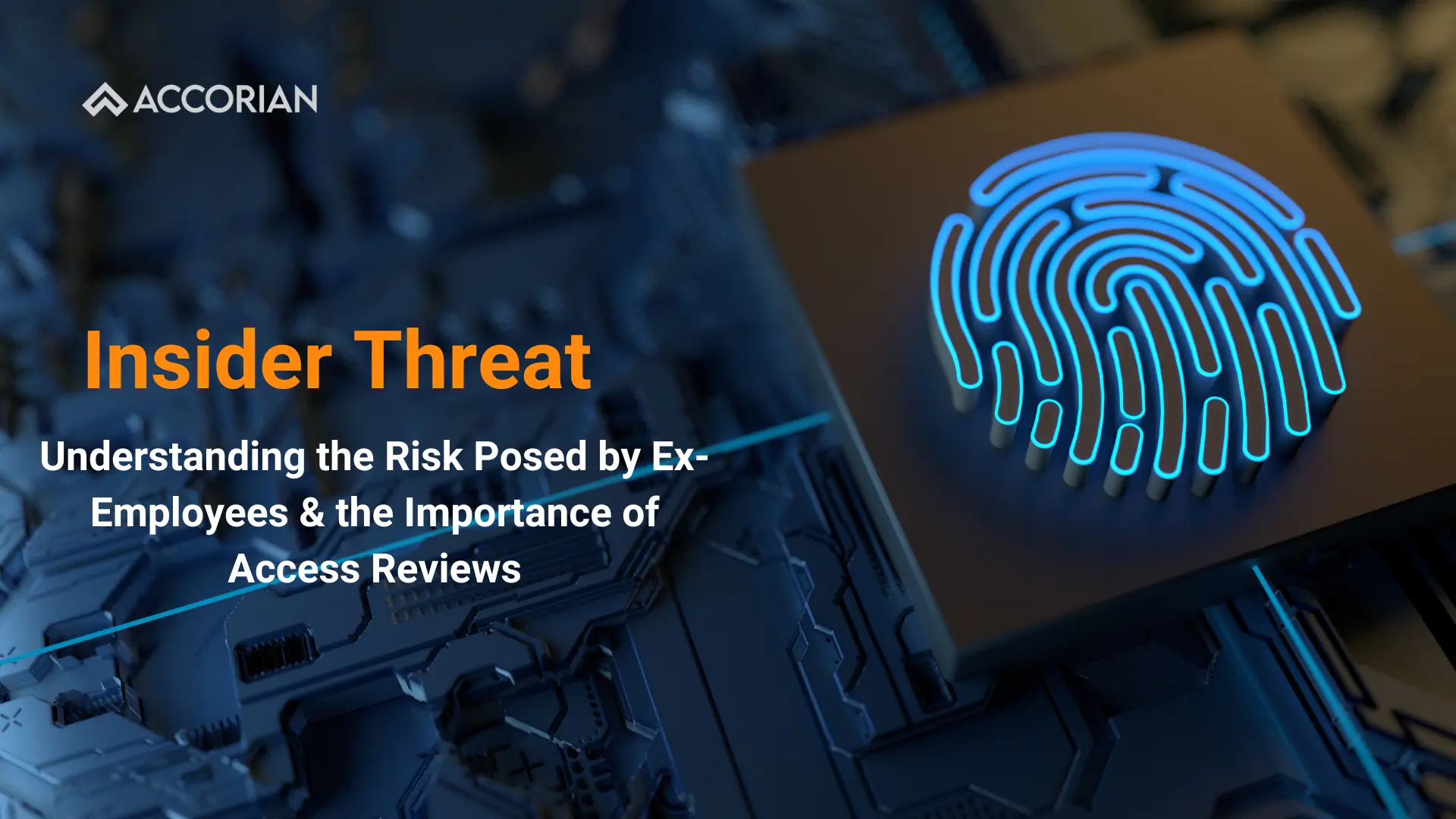Written By Vignesh M R II
In today’s business landscape, organizations face a plethora of cybersecurity challenges, with insider threats being one of the most formidable adversaries which can inflict severe damage on an organization’s financial stability, reputation, and overall operational effectiveness, regardless of whether they are deliberate or not. According to the Ponemon Institute research report, the average cost incurred by an insider threat incident in 2020 amounted to $11.45 million, with an average containment time of 77 days.
What is an Insider Threat?
An insider threat refers to any risks and vulnerabilities arising from individuals who possess authorized access to an organization’s systems, data, or networks. This includes current employees, contractors, and ex-employees who retain access credentials.
While insider threats can emerge in different forms, ranging from inadvertent errors to acts of negligence, the potential risk posed by ex-employees is particularly alarming.
Organizations must proactively manage and monitor access rights when employees leave, mitigating the likelihood of unauthorized exploitation or misuse of their credentials. Therefore, access reviews play a key role in ensuring that only authorized personnel have appropriate time-bound access to critical resources.
Types of Insider Threats
Insider threats can be classified into three main categories:
A. Malicious Insiders:
These are individuals who deliberately exploit their authorized access for personal gain, seeking revenge or causing harm to the organization. Their actions may involve illicit activities such as unauthorized acquisition of confidential information, damaging systems/networks, or engaging in other malicious activities.
B. Negligent Insiders:
These are individuals who unintentionally expose the organization to risks due to their carelessness, lack of awareness, or ignorance of security policies and procedures. Their actions may include unintentional deletion or leakage of critical information, falling victim to social engineering assaults, or committing errors compromising security measures.
C. Compromised Insiders:
These are individuals who have had their access credentials compromised by external threat actors through tactics such as phishing, password attacks, or other cyber-attacks. Once the attackers gain control of these credentials, they can exploit them to use unauthorized access to the organization’s systems or data.
Understanding Ex-Employee Insider Threats
When an employee resigns voluntarily or involuntarily and leaves the company, there remains a concerning possibility that they may still have access to the organization’s networks, systems, and data. This is alarming, particularly because former employees may pose a serious insider threat risk.
Ex-employees can pose significant insider threat risks due to various factors, including:
A. Disgruntled or Revengeful Ex-Employees:
Employees who leave the organization on unfavorable terms, such as termination or layoff, may harbor feelings of anger or resentment. Some former employees with negative sentiments may intentionally exploit their access privileges to seek revenge, cause harm to the business, or steal sensitive data.
B. Unauthorized Retention of Access Credentials:
Ex-employees may either intentionally or unintentionally retain access credentials, such as passwords, access cards, or other authentication mechanisms, even after they depart from the organization. This unauthorized retention of credentials could enable them to gain illicit access to the organization’s systems or data.
C. Unintentional Risk Due to Lack of Access Removal:
In certain cases, the revocation of ex-employees access privileges may be delayed or overlooked due to administrative errors or inadequate processes. As a result, former employees might still have access to key resources even after their employment, unintentionally exposing the organization to insider threats.
D. Ex-Employees with Insider Knowledge:
Ex-employees who possess in-depth knowledge of the organization’s systems, processes, and operations may pose a significant insider threat. They may leverage their insider information to access restricted areas, take advantage of security flaws, or cause harm to the organization’s resources and reputation.
E. Contractors and Third-Party Vendors:
Although not classified as ex-employees, contractors or third-party vendors who have been granted temporary access to the organization’s systems or data can also pose an insider threat. Therefore, revoking their access promptly upon contract termination or engagement completion is crucial to mitigate the risk of potential misuse or abuse.
Importance of Access Reviews
Access Reviews, also known as access audits or entitlement reviews, are crucial to an organization’s cybersecurity strategy to reduce insider risks. These reviews involve periodic assessments and verification of the access rights and permissions assigned to employees, subcontractors, and other users, ensuring alignment with their job responsibilities and organizational requirements.
Significance of Access Reviews
The significance of access reviews can be attributed to the following reasons:
1. Identifying and Revoking Unauthorized Access:
Access reviews enable organizations to identify and revoke any unauthorized access held by ex-employees or other users. Regularly reviewing access rights allows organizations to promptly detect and remove access that lacks proper authorization, effectively mitigating the risk of insider threats.
2. Managing Role Change and Access Responsibilities:
As employees’ job role evolves, their access requirements may evolve accordingly. Access reviews ensure that access rights align with current roles and responsibilities, reducing the potential risk of unauthorized access due to outdated permissions.
3. Detecting and Remediating of Anomalous Access Patterns:
Access reviews aid in the detection of abnormal access patterns or behaviors that may indicate insider threats. When access from an ex-employee’s account is detected after their departure, particularly to sensitive information or systems, it may raise concerns and lead to additional scrutiny and appropriate action.
4. Enforcing the Principle of Least Privilege:
This fundamental cybersecurity practice restricts user access permissions to the bare minimum necessary for their job functions. Access reviews ensure that users only possess access to the resources and data essential for their roles, reducing the risk of unauthorized access and data breaches.
5. Meeting Compliance and Regulatory Requirements:
Various industries impose stringent compliance and regulatory requirements that mandate regular access reviews. By conducting access reviews, organizations demonstrate compliance with industry standards and regulations, furnishing evidence of regular reviews and audits of access rights.
6. Enhancing Accountability and Auditing Capabilities:
Access reviews foster employees’ accountability by ensuring periodic validation and review of access rights. They also establish an audit trail of access changes, enabling organizations to track and monitor access activities. This audit trail is valuable during audit assessments promoting transparency and effective governance.
Best Practices for Access Reviews
Organizations should incorporate access reviews into their cybersecurity plans to effectively manage the internal risks posed by former employees and other users. Below are the guidelines for conducting access reviews:
1. Establish Clearly Defined Access Review Processes:
Implement well-defined processes and procedures for conducting access reviews, including the frequency, scope, roles, and responsibilities of individuals involved in the review process.
2. Conduct Regular and Timely Access Reviews:
Regular and timely access reviews should be performed based on the organization’s risk profile and industry requirements. Prompt reviews ensure the validation of access rights and timely revocation of unauthorized access.
3. Validate Access Rights against Job Responsibilities:
Ensure that access rights granted to users align with their job responsibilities and adhere to the principle of least privilege. It is essential to validate that users have access only to the resources necessary to perform their job functions.
4. Involve Multiple Stakeholders:
Engage multiple stakeholders, including IT administrators, human resources, and business owners, in the access review process. This collaborative approach ensures comprehensive reviews by leveraging technical expertise, verifying job roles, and validating access necessity.
5. Automate Access Review Processes:
Leverage automation technologies and solutions to streamline access review procedures, reduce human errors, and ensures reliable evaluations.
6. Review All Types of Access:
Include physical access, application access, and other forms of accessing the review process, not solely focusing on system or network access. This comprehensive approach examines all access points, minimizing potential access management gaps.
7. Monitor and Detect Abnormal Access Patterns:
Incorporate monitoring and detecting mechanisms to identify abnormal access patterns or behaviors. This can be achieved by utilizing advanced analytics, machine learning algorithms, security information, and event management (SIEM) systems that can detect anomalies in access activities and trigger alerts for further investigation.
8. Take Prompt Action on Access Review Findings:
Act swiftly on access review findings. Immediately revoke unauthorized or unnecessary access and enforce appropriate actions against violators. This ensures the timely alignment of access rights with job roles and responsibilities.
9. Regularly Review and Update Access Review Processes:
Regularly review and update access review processes to adapt to organizational structure, systems, and process changes. This ensures ongoing effectiveness in mitigating insider threats and meeting compliance requirements.
Stay Ahead of Insider Threats with Accorian: Your Trusted Cybersecurity Advisory Firm
Accorian is a leading cybersecurity advisory firm specializing in providing comprehensive assessments and strategic guidance to address insider threats and other cybersecurity challenges. Our expertise and experience can assist organizations in implementing effective access review processes, ensure the protection of critical assets/data, and strengthen your cybersecurity posture.
Partner with us today!



